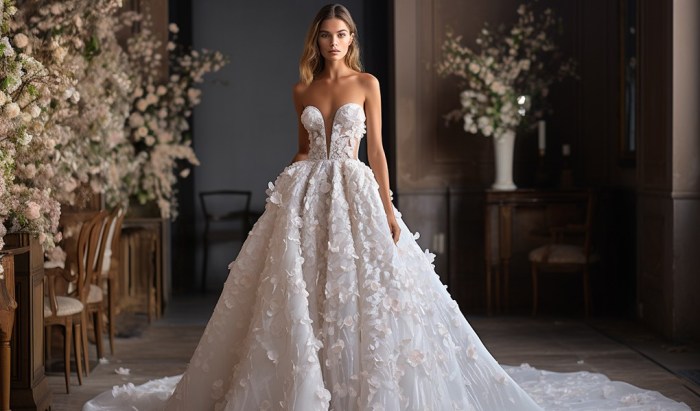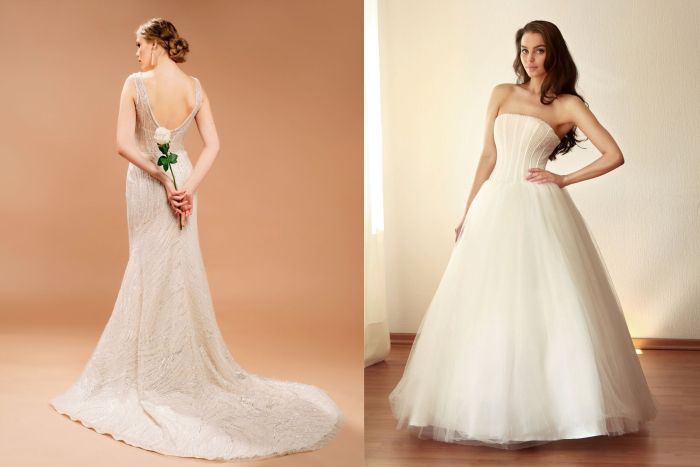White and Ivory Wedding Dresses A Comprehensive Guide
Shades of White and Ivory
White and ivory wedding dress – The choice between white and ivory for a wedding dress significantly impacts the overall aesthetic. Subtle variations in shade create dramatically different looks, influencing how the dress complements the bride’s complexion and the wedding’s theme. Understanding these nuances is crucial for selecting the perfect gown.
Shades of White
Pure white, often referred to as “bright white” or “stark white,” offers a classic, timeless elegance. It pairs beautifully with crisp, clean lines and minimalist designs. This shade is particularly stunning in fabrics like silk charmeuse, which drapes exquisitely, showcasing the inherent luminosity of the fabric. On the other hand, a softer white, like “off-white,” provides a more relaxed and romantic feel.
It’s ideal for lace or tulle gowns, lending a gentle, ethereal quality. Off-white tends to be more flattering on a wider range of skin tones than stark white.
Shades of Ivory
Ivory encompasses a range of creamy, warm tones. “Antique ivory” has a yellowish hue, reminiscent of aged parchment, adding a touch of vintage charm. It complements lace and satin beautifully. “Cream ivory” is a softer, lighter shade, lending itself to a more modern and understated look. It looks particularly striking in silk crepe or Mikado silk.
“Champagne ivory” has a subtle pinkish undertone, lending a romantic and sophisticated air, particularly flattering on those with warm undertones.
Fabric and Skin Tone Considerations
The choice of fabric further accentuates the shade of the dress. Silk satin amplifies the brightness of white, while matte fabrics like crepe or matte jersey soften the impact of both white and ivory. Pure white can sometimes wash out individuals with fair complexions, while ivory shades tend to be more universally flattering, especially for those with warmer skin tones.
A color consultation with a professional stylist can help determine the most flattering shade for an individual’s complexion.
Sample Wedding Color Palette

Source: inweddingdress.com
A wedding incorporating various shades of white and ivory could include:
- Main Dress: Off-white silk crepe
- Bridesmaids Dresses: Champagne ivory chiffon
- Table Linens: Antique ivory linen
- Floral Arrangements: Blush pink roses and ivory hydrangeas
- Stationery: Cream ivory with calligraphy in a dark grey ink
Fabric Choices for White and Ivory Dresses
The fabric chosen for a wedding dress profoundly influences its drape, texture, and overall aesthetic. Each fabric possesses unique properties that impact the final look and feel of the gown.
Fabric Properties and Drape, White and ivory wedding dress
Silk, known for its luxurious sheen and fluidity, creates a graceful drape, particularly in charmeuse and satin variations. Lace, with its intricate patterns, adds a touch of romanticism and texture. Tulle, a lightweight netting, is often used for voluminous skirts and overlays, offering a delicate and airy feel. Satin’s smooth surface reflects light beautifully, creating a glamorous effect.
Organza, a stiffer fabric, provides structure and shape, ideal for structured silhouettes.
Fabric Examples in Wedding Dress Designs
A-line gowns often incorporate flowing fabrics like chiffon or crepe for a relaxed, elegant look. Ball gowns frequently use tulle or organza for their voluminous skirts. Mermaid gowns often utilize satin or silk for their form-fitting silhouette. Sheath dresses often incorporate crepe or jersey for a sleek, modern aesthetic.
The timeless elegance of white and ivory wedding dresses often inspires the attire of wedding guests. Choosing a flattering guest dress is key, and for those with a pear-shaped body, finding the perfect fit is paramount. Consider checking out helpful resources like this guide on wedding guest dresses for pear shaped body to complement the bride’s stunning white or ivory gown.
Ultimately, tasteful guest attire enhances the overall celebratory atmosphere surrounding the wedding’s central focus: the bride’s beautiful dress.
Fabric Comparison Table
| Fabric | Cost | Durability | Care |
|---|---|---|---|
| Silk | High | Moderate | Dry clean |
| Satin | Medium | Moderate | Dry clean |
| Lace | Medium-High | Moderate | Dry clean |
| Tulle | Low | Low | Dry clean |
Wedding Dress Silhouettes in White and Ivory
The silhouette of a wedding dress plays a pivotal role in determining its overall look and how it flatters the bride’s figure. Understanding different silhouettes helps brides choose a style that complements their body type and personal style.
Silhouette Descriptions and Body Type Considerations
The A-line silhouette, with its fitted bodice and gradually widening skirt, is universally flattering. The ballgown, featuring a fitted bodice and a full, voluminous skirt, is ideal for creating a dramatic and romantic look. The mermaid silhouette, fitted through the hips and flaring out at the knees, accentuates curves. The sheath silhouette, straight and close-fitting, is sleek and modern.
The empire waist silhouette, with a high waistline, elongates the torso and is flattering on various body types.
Silhouette Visual Descriptions
The A-line creates a graceful, triangular shape, flowing smoothly from the shoulders to the floor. The ballgown presents a dramatic contrast between a fitted bodice and a full, circular skirt. The mermaid hugs the body closely, accentuating the curves before flaring dramatically at the knees, resembling a mermaid’s tail. The sheath creates a clean, streamlined vertical line, highlighting the body’s natural shape.
The empire waist emphasizes a high waistline, creating a flowing, romantic look that gracefully skims the body.
Venue and Style Suitability
A ballgown is well-suited for grand venues like churches or ballrooms, while a sheath dress might be more appropriate for a modern, minimalist wedding. An A-line gown is versatile and works well in various settings. A mermaid gown is often chosen for more formal occasions. An empire waist dress is ideal for outdoor or beach weddings due to its lightness and ease of movement.
Embellishments and Details

Source: weddbook.com
Embellishments add personality and sophistication to white and ivory wedding dresses, elevating the design from simple to stunning. The type, placement, and density of embellishments significantly impact the overall formality and style of the gown.
Embellishment Types and Formality
Delicate beading creates a subtle sparkle, suitable for both casual and formal weddings. Intricate embroidery adds a touch of artistry and elegance, often found in more formal gowns. Lace appliqués offer a romantic and delicate touch, ranging from simple to ornate depending on the design. Sequins provide a glamorous, eye-catching effect, ideal for evening or formal weddings.
3D floral appliqués add a unique textural element, perfect for adding a touch of whimsy.
Embellishment Placement and Design Impact
Embellishments concentrated on the bodice create a focal point, drawing attention to the upper body. Embellishments cascading down the skirt add movement and drama. Strategic placement of embellishments can also highlight specific design elements, such as the waistline or neckline. Subtle embellishments create a refined look, while heavier embellishments add a more dramatic effect.
Embellishment Pattern Designs
Design 1: Delicate floral embroidery scattered across the bodice and trailing down the skirt, creating a romantic and whimsical feel.
Design 2: Intricate beading outlining the neckline and waistline, adding a touch of glamour and sophistication.
Design 3: Lace appliqués strategically placed on the sleeves and train, adding a touch of elegance and detail.
Accessories for White and Ivory Dresses
Accessories play a crucial role in completing the wedding day look. They can enhance the dress’s design, add personality, and reflect the bride’s style. Careful selection of accessories ensures a cohesive and harmonious overall aesthetic.
Accessory Examples and Style Alterations
A cathedral-length veil adds a touch of classic elegance, while a birdcage veil offers a more vintage and playful feel. Statement jewelry, like a bold necklace or earrings, can draw attention to the bride’s face. Simple, delicate jewelry complements a more understated look. Shoes, whether heels or flats, can add a touch of personality and reflect the wedding’s style and venue.
Accessory Suggestions for Different Wedding Styles
- Rustic Wedding: Floral crown, delicate jewelry, ankle-strap sandals.
- Modern Wedding: Sleek, minimalist jewelry, simple heels, a short veil or no veil.
- Classic Wedding: Cathedral-length veil, pearl jewelry, elegant heels.
Harmonizing Accessories with Dress

Source: weddingpioneer.com
Accessories should complement the dress’s fabric and embellishments. For a lace dress, delicate jewelry and a lace veil would be a harmonious choice. For a simpler dress, statement jewelry or a bold accessory can add a touch of personality. The overall color palette should also be considered to maintain a cohesive look.
Styling White and Ivory Dresses for Different Venues: White And Ivory Wedding Dress
Styling a wedding dress for a specific venue enhances the overall aesthetic and ensures the bride feels comfortable and confident. The venue’s style and ambiance should inform the styling choices, creating a cohesive and memorable look.
Venue-Specific Styling and Makeup
A beach wedding calls for a relaxed, flowing dress, perhaps with a flower crown and natural makeup. A garden wedding might incorporate a more romantic dress, with loose curls and natural makeup. A church wedding often involves a more formal dress, with a classic updo and more polished makeup.
Venue-Specific Accessory Table
| Venue | Hair | Makeup | Accessories |
|---|---|---|---|
| Beach | Loose waves | Natural | Flower crown, sandals |
| Garden | Loose curls | Romantic | Delicate jewelry, flower crown |
| Church | Updo | Classic | Cathedral-length veil, elegant jewelry |
Weather Considerations
Weather conditions can influence styling choices. For outdoor weddings, a light fabric like chiffon or tulle might be more comfortable in warm weather. In colder weather, a heavier fabric like satin or velvet might be preferred. A jacket or shawl can also be incorporated to provide warmth and add a stylish touch.
FAQs
What’s the difference between ivory and off-white?
Off-white has a slightly gray or beige undertone, while ivory leans more towards a creamy yellow.
Can I wear ivory if I have a warm skin tone?
Ivory generally complements warm skin tones well, but the specific shade depends on your exact complexion.
How do I choose the right veil for my dress?
Consider the neckline, silhouette, and overall formality of your dress when selecting a veil. A simple dress might pair well with an elaborate veil, while a heavily embellished dress may look better with a simpler veil.
How do I clean my wedding dress after the wedding?
Professional dry cleaning is recommended to preserve the fabric and embellishments. Follow the care instructions provided by the manufacturer.

















